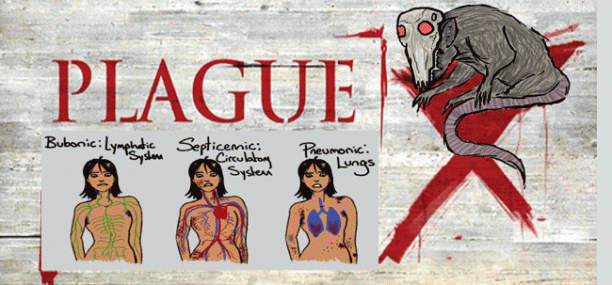Plague (Чума)
Plague (Чума, الطاعون) is a severe life threatening infectious disease caused by the bacterium genus Yersinia pestis, it is characterized by a wide range of signs and symptoms affecting the whole body. Symptoms usually develop gradually and may vary from mild to severe; However, without prompt treatment, it can cause serious complications and may lead to death. In most cases of Plague symptoms appear suddenly, Infected persons usually develop Flu-like symptoms after an incubation period of 3-7 days.
Plague is a zoonotic bacterial infection transmissible to the humans and without standard precautions it may spread through one or several communities, which, in turn, may lead to an epidemic outbreak.
| Classification: | |||
| Local forms | Externally-disseminated forms | Internally-disseminated (generalized) | |
|
|
|
|
Pathogen – Yersinia Pestis
Epidemiology
The source of infection:
- From infected rodents
- From sick domestic animals (donkeys, camels, etc.)
- From a sick man.

Mechanism of transmission:
- Aerogenic (from patients with pneumonic plague)
- Transmissive (from a bite of infected fleas)
- Alimentary (by utilizing contaminated products, and consuming raw-uncooked foods)
- By means of contact (through the skin).
Clinical picture
The incubation period ranges from 2 to 6 days.
Plague is characterized with an acute onset, symptoms usually develop suddenly and progresses quickly.
Intoxication syndrome, In plague symptoms develop suddenly, and temperature may also rise to reach 39 – 40 ° C (subfebrile fever), which is often accompanied by strong chills, headache, dizziness, severe weakness, insomnia, muscle pain, nausea, vomiting.
The skin feels hot to touch, dry skin, hyperemic face, puffy, subsequently with cyanotic shade.
In severe cases, petechiae and rash are observed on the skin.

Gastrointestinal tract,
Thickened tongue, with cracks and scabs, covered with a thick white coating. Moreover, the patient may notice tongue tremors.
In severe cases, patients may suffer from bloody vomiting, loose stools with mucus and blood.
Cutaneous plague
The formation of necrotic ulcers passes through successive stages: it starts with the formation of a papule (a small raised spot on the skin), these papules then develop into vesicles or pustules, which may rupture and turn into erosions or sharply painful ulcers that finally crusts. The crusts eventually fall off, leaving a scar.
Differential diagnosis is carried with Cutaneous Anthrax
Bubonic plague
Plague buboes (the bubo of plague) – a sharply painful swelling of the lymph nodes, enlarged in size, soldered with the surrounding subcutaneous tissue, skin over bubo is hyperemic, tense, shiny (not changed in the first days of illness).

Differential diagnosis
The differential diagnosis is carried out with the bubonic form of tularemia lymphadenitis, Hodgkin’s disease.
Cutaneous-bubonic Plague
It combines the clinical pictures of cutaneous and bubonic forms of the disease.
Primary-septic Plague
This form is characterized by severe intoxication, in most patients the symptoms of toxic shock syndrome (TSS) start suddenly and get worse quickly over a short period of time (2-3 days after infection). Patients with Primary-Septicemic plague often develop cardiovascular disease and hemorrhagic syndrome, which is associated with a high mortality rate.
The differential diagnosis is carried out with typhus, meningococcemia.
Primary-pneumonic Plague
The appearance of hemorrhagic viscous sputum on the background of pneumonia, altogether with the development of respiratory failure, and progressive circulatory failure, which often presents with pulmonary edema are characteristic for this form of plague.
Differential diagnosis is carried with inhalation anthrax, or lobar pneumonia.
Secondary-septic and secondary pneumonic plague occur as a secondary disease following any form of plague, these forms carry no fundamental differences from the primary forms of the disease.
The intestinal form of plague
It arises on the background of generalized forms of plague, and presents with abdominal pain, stool with abundant admixture of blood and mucus.
Laboratory diagnosis
Detection of Yersinia pestis by smears or culture such as a blood film or peripheral blood smear, sputum, feces, tissues of dead animals, or lymph node specimen, Bacteriological tests for plague, Biological (by infecting laboratory animals), Serological (TPHA, ELISA, etc.).
Treatment
Causal treatment
The drug of choice is streptomycin (or any other aminoglycoside) up to 3g / day. For localized forms, up to 4g / day. For the treatment of generalized form, streptomycin is given in combination with tetracycline (a combination of antibiotics).
The universal course of treatment of patients with plague (regardless of the form they are suffering from) ranges between 7-10 days.
Pathogenetic therapy
- Detoxification agents
Symptomatic treatment: cardiovascular drugs, and analgesics.
Verified by: Dr.Diab (October 8, 2017)
Citation: Dr.Diab. (October 8, 2017). Plague Classification Epidemiology Clinic and Treatment. Medcoi Journal of Medicine, 9(2). urn:medcoi:article16385.














There are no comments yet
Or use one of these social networks